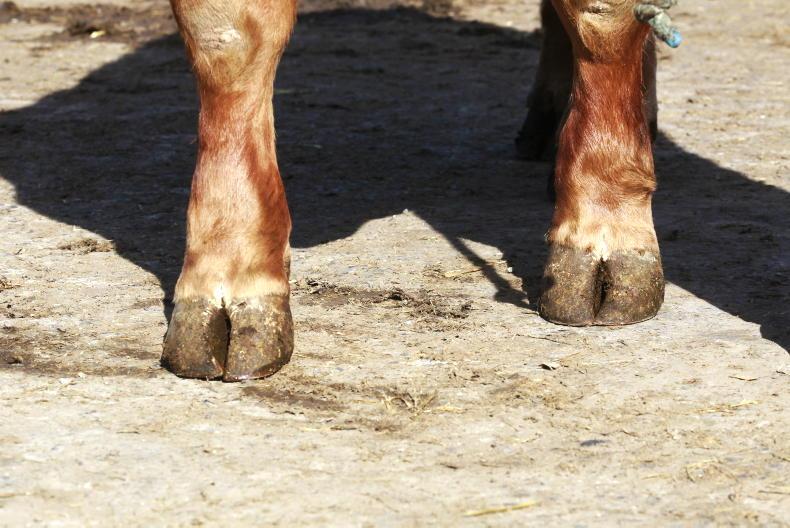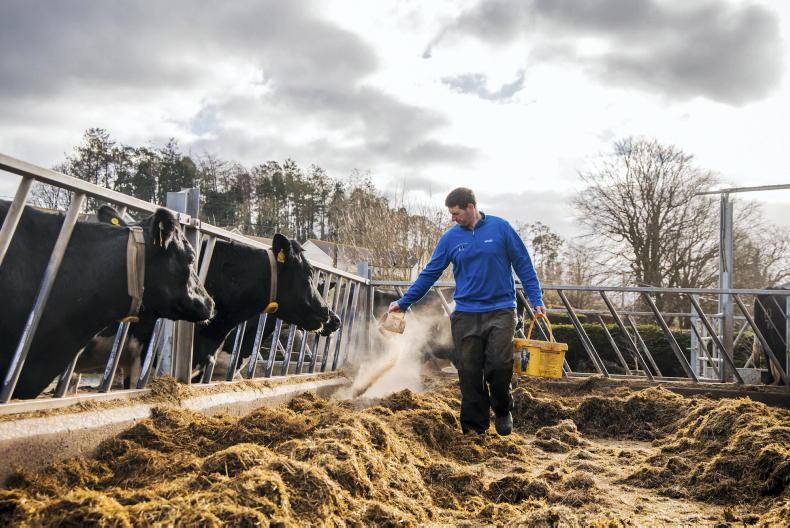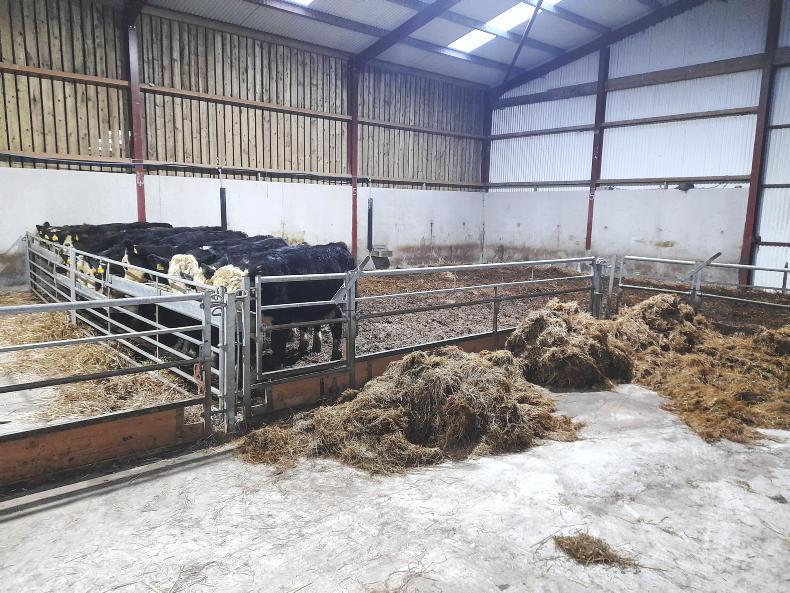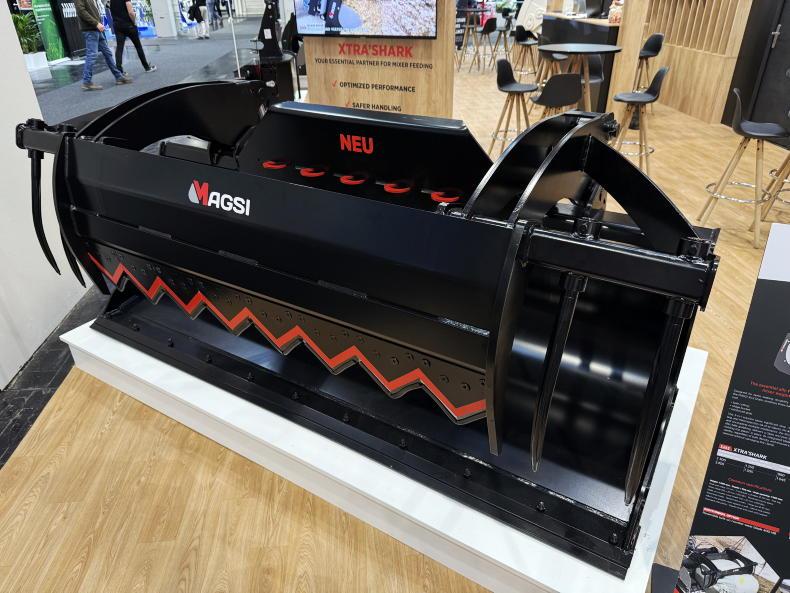On Thursday 15 December, the NI sheep programme will host a webinar covering the topics of silage quality and feeding concentrates in the run-up to lambing next spring.
On the evening, programme farmer James McCay will outline the winter feeding plans for his 300 ewes and give an update on the health routine from autumn through to lambing time.
Leading the discussion will be programme adviser, Senan White, along with CAFRE beef and sheep adviser Jack Friar.
Starting at 7:30pm, the event is open to all farmers with pre-registration required through the CAFRE or Irish Farmer Journal websites.
Farm background
James farms 130ha of grassland in an upland and hill environment outside Drumquin, Co Tyrone, with land running to just over 900ft in elevation.
The 300 ewes are split evenly between a pure hill flock with Perth-type Scottish Blackface ewes and a crossbred flock with Mule, Texel and Suffolk breeding.
Upland ewes start lambing from mid-March with all animals brought indoors for ease of management.
The hill ewes start lambing around two weeks later and again, lambing takes place indoors, with ewes and their progeny turned back to grass after 24 hours of being born.
Around 30% to 35% of lambs are sold direct for slaughter through Dunbia, with a similar number of later-born lambs sold through the store ring in autumn.
Flock replacements are bred on farm with approximately 50 ewes retained from the upland ewes and 50 ewe lambs kept from the hill flock.
Breeding
Breeding is now coming to an end on farm.
Rams were turned out to crossbred ewes in mid-October and early November for the hill flock.
Prior to the rams going out, ewes were drenched for fluke and given a mineral bolus, as well as a mineral drench, then grouped for breeding.
In the past, blood samples indicated ewes were low in selenium and cobalt and this filtered through to lamb vigour around lambing time.
On the evening, James will give more of an insight into his health programme, which also includes vaccinating for enzootic abortion and toxoplasmosis, as well as clostridial diseases.
Crossbred ewes are mated to Blue Leicester, Suffolk and Charollais rams.
A Texel ram was given a limited number of ewes to mate, partly to make sure the tup was working before going to hill ewes.
Hill ewes are cross to Blackface, Swaledale and the Texel ram, which runs with a carefully chosen group of Blackface ewes. Some of the female progeny from this cross join the upland flock for breeding.
The continental genetics improved liveweight gain and conformation of hill lambs, thereby increasing sale value.
The Swaledale ram has been introduced to bring some hybrid vigour into the hill flock, and hopefully reduce the number of barren ewes in future.
Improving grassland
Over the past few years, James has been making changes to improve his grassland setup for both grazing and silage.
Soil testing has shown a need to raise pH levels and, this year alone, James has spread 80t of lime.
He is also targeting farmyard manure and slurry to certain fields to raise P and K levels. Reseeding is also ongoing to improve grass yields.

Breeding is almost over for the 300 breeding ewes on James' farm.
But given the farm’s upland location and the demand for grass post-lambing, most reseeding work is carried out in a short window around late June to late July.
Silage quality
Silage swards have been reseeded and efforts have been made to make high-quality silage as a means of reducing concentrate levels pre-lambing.
James has his own mower and cuts silage as soon as ground and weather allow, as well as at a time when grass is ready to cut.
All silage is made in bale form using a local contractor. Around 120 bales were made on 4 June with a similar volume of bales carried over from the previous year.
Silage analysis indicates 15.62% crude protein, 10.76 ME (energy), 21% dry matter and 67 D-value (71% DMD).
Part of the flock is wintered on temporary grazing on a neighbouring farm, with the remainder grazed on improved land on the home farm.
However, to build grass for spring, the ewes wintered on the home farm will come indoors prior to Christmas and offered bale silage, starting with the carryover of fodder from last year.
The 2022 bales will be fed closer to lambing time. By feeding the 2021 bales first, if there is a carryover of silage left at the end of winter, it will be all 2022 silage stocks being carried forward.
Scanning will be carried out in January. Supplementary feeding will start around six weeks prior to lambing, depending on ewe condition and litter size.
Meal is built up rather than offered on a flat rate. Meal starts off at 0.2kg/head/day, building to 0.4kg/day then 0.5kg/day. Single bearing ewes are also well supplemented pre-lambing. James will cross-foster lambs on to singles, so he feeds ewes to drive milk production.
Post-lambing, meal feeding continues for another two to four weeks depending on weather and grass supplies as snow and heavy frost are common on the farm in spring.
To watch the webinar on Thursday 15 December (7.30pm start), pre-register at the CAFRE events online and log-in details will be sent via e-mail.
130ha upland grass and hill unit.150 Scottish Blackface ewes.150 crossbred ewes.Lambs sold fat and as stores.
Read more
Sheep price update: stickier trade as factories look to pull prices by 10c/kg
Deadline for Sheep Improvement Scheme applications extended
On Thursday 15 December, the NI sheep programme will host a webinar covering the topics of silage quality and feeding concentrates in the run-up to lambing next spring.
On the evening, programme farmer James McCay will outline the winter feeding plans for his 300 ewes and give an update on the health routine from autumn through to lambing time.
Leading the discussion will be programme adviser, Senan White, along with CAFRE beef and sheep adviser Jack Friar.
Starting at 7:30pm, the event is open to all farmers with pre-registration required through the CAFRE or Irish Farmer Journal websites.
Farm background
James farms 130ha of grassland in an upland and hill environment outside Drumquin, Co Tyrone, with land running to just over 900ft in elevation.
The 300 ewes are split evenly between a pure hill flock with Perth-type Scottish Blackface ewes and a crossbred flock with Mule, Texel and Suffolk breeding.
Upland ewes start lambing from mid-March with all animals brought indoors for ease of management.
The hill ewes start lambing around two weeks later and again, lambing takes place indoors, with ewes and their progeny turned back to grass after 24 hours of being born.
Around 30% to 35% of lambs are sold direct for slaughter through Dunbia, with a similar number of later-born lambs sold through the store ring in autumn.
Flock replacements are bred on farm with approximately 50 ewes retained from the upland ewes and 50 ewe lambs kept from the hill flock.
Breeding
Breeding is now coming to an end on farm.
Rams were turned out to crossbred ewes in mid-October and early November for the hill flock.
Prior to the rams going out, ewes were drenched for fluke and given a mineral bolus, as well as a mineral drench, then grouped for breeding.
In the past, blood samples indicated ewes were low in selenium and cobalt and this filtered through to lamb vigour around lambing time.
On the evening, James will give more of an insight into his health programme, which also includes vaccinating for enzootic abortion and toxoplasmosis, as well as clostridial diseases.
Crossbred ewes are mated to Blue Leicester, Suffolk and Charollais rams.
A Texel ram was given a limited number of ewes to mate, partly to make sure the tup was working before going to hill ewes.
Hill ewes are cross to Blackface, Swaledale and the Texel ram, which runs with a carefully chosen group of Blackface ewes. Some of the female progeny from this cross join the upland flock for breeding.
The continental genetics improved liveweight gain and conformation of hill lambs, thereby increasing sale value.
The Swaledale ram has been introduced to bring some hybrid vigour into the hill flock, and hopefully reduce the number of barren ewes in future.
Improving grassland
Over the past few years, James has been making changes to improve his grassland setup for both grazing and silage.
Soil testing has shown a need to raise pH levels and, this year alone, James has spread 80t of lime.
He is also targeting farmyard manure and slurry to certain fields to raise P and K levels. Reseeding is also ongoing to improve grass yields.

Breeding is almost over for the 300 breeding ewes on James' farm.
But given the farm’s upland location and the demand for grass post-lambing, most reseeding work is carried out in a short window around late June to late July.
Silage quality
Silage swards have been reseeded and efforts have been made to make high-quality silage as a means of reducing concentrate levels pre-lambing.
James has his own mower and cuts silage as soon as ground and weather allow, as well as at a time when grass is ready to cut.
All silage is made in bale form using a local contractor. Around 120 bales were made on 4 June with a similar volume of bales carried over from the previous year.
Silage analysis indicates 15.62% crude protein, 10.76 ME (energy), 21% dry matter and 67 D-value (71% DMD).
Part of the flock is wintered on temporary grazing on a neighbouring farm, with the remainder grazed on improved land on the home farm.
However, to build grass for spring, the ewes wintered on the home farm will come indoors prior to Christmas and offered bale silage, starting with the carryover of fodder from last year.
The 2022 bales will be fed closer to lambing time. By feeding the 2021 bales first, if there is a carryover of silage left at the end of winter, it will be all 2022 silage stocks being carried forward.
Scanning will be carried out in January. Supplementary feeding will start around six weeks prior to lambing, depending on ewe condition and litter size.
Meal is built up rather than offered on a flat rate. Meal starts off at 0.2kg/head/day, building to 0.4kg/day then 0.5kg/day. Single bearing ewes are also well supplemented pre-lambing. James will cross-foster lambs on to singles, so he feeds ewes to drive milk production.
Post-lambing, meal feeding continues for another two to four weeks depending on weather and grass supplies as snow and heavy frost are common on the farm in spring.
To watch the webinar on Thursday 15 December (7.30pm start), pre-register at the CAFRE events online and log-in details will be sent via e-mail.
130ha upland grass and hill unit.150 Scottish Blackface ewes.150 crossbred ewes.Lambs sold fat and as stores.
Read more
Sheep price update: stickier trade as factories look to pull prices by 10c/kg
Deadline for Sheep Improvement Scheme applications extended












SHARING OPTIONS